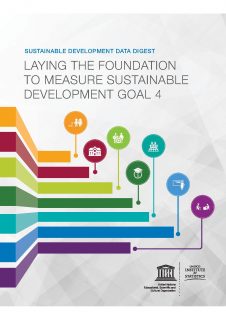12-08-2016 | ‘Gelijkwaardig en goed onderwijs voor iedereen’ sprak de wereldgemeenschap vorig jaar af. Maar wat houdt dat in en hoe meet je het? Het UNESCO Instituut voor Statistiek (UIS) brengt alle gegevens samen. Het UIS-rapport ‘Laying the foundation to measure SDG4’ beschrijft hoe de doelen worden gemeten en hoe goed dat lukt.
 Leading the agenda for the production of data to monitor Education 2030
Leading the agenda for the production of data to monitor Education 2030
The UIS launches the Sustainable Development Data Digest as part of an ambitious set of initiatives for the monitoring and implementation of the SDG 4 – Education 2030 agenda.
With Sustainable Development Goal (SDG 4), the international community has pledged to ‘ensure inclusive and equitable quality education and promote lifelong learning opportunities for all’. This will require tremendous efforts on the part of all stakeholders, notably governments, donors and international organizations.
As the agency mandated to produce the data needed to monitor progress, the UIS is taking the lead on a several fronts, in close consultation with partners, to develop the standards and methodologies to produce a new generation of education data with a specific focus on learning.
New and improved data and indicators are needed to monitor progress, identify bottlenecks and sharpen policies to ensure that every dollar invested in education makes a tangible difference to people’s lives. At present, however, the world gathers only around one-half of the data needed to monitor progress based on SDG 4 global education indicators.
The new UIS Sustainable Development Data Digest and UNESCO eAtlas for Education 2030 are the latest in a set of initiatives designed to address gaps in data and to coordinate expertise and thought leadership on the evolution of the current monitoring agenda.
‘Laying the Foundation to Measure Sustainable Development Goal 4’, the Digest shows that many countries struggle to produce the data that are needed today and will find it even harder to gather the finely-tuned education data that are needed in the coming years, given the vast ambitions of the SDG agenda.
To address this challenge, the Digest presents a global strategy involving countries, UN agencies, donors and civil society groups to gather the necessary data and implement a new measurement framework.
It focuses specifically on areas that are difficult to measure, such as education quality, learning, equity and inclusion. The Digest highlights, for example, the ways in which parity indices can be used to track inequalities in education and learning among children and youth according to their socio-economic status, location (rural versus urban households), sex and disability status.
The UIS is working closely with countries to identify data gaps, for example, and use a wider range of different data sources. This requires renewed commitment by governments and the UIS Digest argues that this commitment is essential for the achievement of key SDG education targets.
